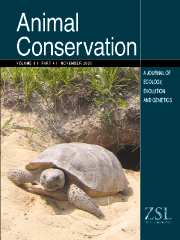Crossref Citations
This article has been cited by the following publications. This list is generated based on data provided by
Crossref.
Bremner‐Harrison, S.
Prodohl, P. A.
and
Elwood, R. W.
2004.
Behavioural trait assessment as a release criterion: boldness predicts early death in a reintroduction programme of captive‐bred swift fox (Vulpes velox).
Animal Conservation,
Vol. 7,
Issue. 3,
p.
313.
Preatoni, Damiano
Mustoni, Andrea
Martinoli, Adriano
Carlini, Eugenio
Chiarenzi, Barbara
Chiozzini, Simonetta
Van Dongen, Stefan
Wauters, Luc A.
and
Tosi, Guido
2005.
Conservation of brown bear in the Alps: space use and settlement behavior of reintroduced bears.
Acta Oecologica,
Vol. 28,
Issue. 3,
p.
189.
Tuberville, Tracey D.
Clark, Erin E.
Buhlmann, Kurt A.
and
Gibbons, J. Whitfield
2005.
Translocation as a conservation tool: site fidelity and movement of repatriated gopher tortoises (Gopherus polyphemus).
Animal Conservation,
Vol. 8,
Issue. 4,
p.
349.
Moehrenschlager, Axel
List, Rurik
and
Macdonald, David W.
2007.
Escaping Intraguild Predation: Mexican Kit Foxes Survive While Coyotes and Golden Eagles Kill Canadian Swift Foxes.
Journal of Mammalogy,
Vol. 88,
Issue. 4,
p.
1029.
Teixeira, Camila P.
de Azevedo, Cristiano Schetini
Mendl, Mike
Cipreste, Cynthia F.
and
Young, Robert J.
2007.
Revisiting translocation and reintroduction programmes: the importance of considering stress.
Animal Behaviour,
Vol. 73,
Issue. 1,
p.
1.
Clifford, D. L.
Woodroffe, R.
Garcelon, D. K.
Timm, S. F.
and
Mazet, J. A. K.
2007.
Using pregnancy rates and perinatal mortality to evaluate the success of recovery strategies for endangered island foxes.
Animal Conservation,
Vol. 10,
Issue. 4,
p.
442.
CULLINGHAM, C. I.
SMEETON, C.
and
WHITE, B. N.
2007.
Isolation and characterization of swift fox tetranucleotide microsatellite loci.
Molecular Ecology Notes,
Vol. 7,
Issue. 1,
p.
160.
Ausband, David E.
and
Foresman, Kerry R.
2007.
Swift fox reintroductions on the Blackfeet Indian Reservation, Montana, USA.
Biological Conservation,
Vol. 136,
Issue. 3,
p.
423.
Stamps, Judy A.
and
Swaisgood, Ronald R.
2007.
Someplace like home: Experience, habitat selection and conservation biology.
Applied Animal Behaviour Science,
Vol. 102,
Issue. 3-4,
p.
392.
Dickens, M. J.
Delehanty, D. J.
Reed, J. M.
and
Romero, L. M.
2009.
What happens to translocated game birds that ‘disappear’?.
Animal Conservation,
Vol. 12,
Issue. 5,
p.
418.
Maran, Tiit
Põdra, Madis
Põlma, Merje
and
Macdonald, David W.
2009.
The survival of captive-born animals in restoration programmes – Case study of the endangered European mink Mustela lutreola.
Biological Conservation,
Vol. 142,
Issue. 8,
p.
1685.
Ausband, David
and
Moehrenschlager, Axel
2009.
Long-range juvenile dispersal and its implication for conservation of reintroduced swift fox Vulpes velox populations in the USA and Canada.
Oryx,
Vol. 43,
Issue. 01,
p.
73.
Pinter-Wollman, Noa
Isbell, Lynne A.
and
Hart, Lynette A.
2009.
Assessing translocation outcome: Comparing behavioral and physiological aspects of translocated and resident African elephants (Loxodonta africana).
Biological Conservation,
Vol. 142,
Issue. 5,
p.
1116.
van Heezik, Yolanda
Maloney, Richard F.
and
Seddon, Philip J.
2009.
Movements of translocated captive-bred and released Critically Endangered kaki (black stilts) Himantopus novaezelandiae and the value of long-term post-release monitoring.
Oryx,
Vol. 43,
Issue. 04,
p.
639.
Massei, Giovanna
Quy, Roger J.
Gurney, Joanne
and
Cowan, Dave P.
2010.
Can translocations be used to mitigate human - wildlife conflicts?.
Wildlife Research,
Vol. 37,
Issue. 5,
p.
428.
Swaisgood, RR
2010.
The conservation-welfare nexus in reintroduction programmes: a role for sensory ecology.
Animal Welfare,
Vol. 19,
Issue. 2,
p.
125.
Dickens, Molly J.
Delehanty, David J.
and
Michael Romero, L.
2010.
Stress: An inevitable component of animal translocation.
Biological Conservation,
Vol. 143,
Issue. 6,
p.
1329.
WATERS, S. S.
2010.
Swift fox Vulpes velox reintroductions: a review of release protocols.
International Zoo Yearbook,
Vol. 44,
Issue. 1,
p.
173.
Roe, John H.
Frank, Michael R.
Gibson, Scott E.
Attum, Omar
and
Kingsbury, Bruce A.
2010.
No place like home: an experimental comparison of reintroduction strategies using snakes.
Journal of Applied Ecology,
Vol. 47,
Issue. 6,
p.
1253.
Mitchell, Aimee M.
Wellicome, Troy I.
Brodie, Dawn
and
Cheng, Kimberly M.
2011.
Captive-reared burrowing owls show higher site-affinity, survival, and reproductive performance when reintroduced using a soft-release.
Biological Conservation,
Vol. 144,
Issue. 5,
p.
1382.


